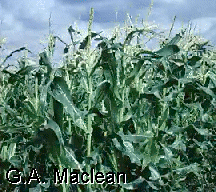
| |
 |
![]()
 Mother Earth News, Sep/Oct 1987
Mother Earth News, Sep/Oct 1987
The Easiest Seed-Saving Crops
By Nancy Bubel
Pollen from the tassels of this wind-pollinated crop land on the silks that line the ears. Popcorn, field corn and sweet corn will all cross with each other. To keep strains pure, then, plant seed varieties that tassel at the same time at least 1,000 feet apart. (Technically speaking, 1/4 mile is ideal.) Or you can avoid crossing by bagging ears you want to save. Before the silk emerges, cover each seed ear with a paper bag closed with a rubber band. When the tassels shed pollen easily, cut a tassel from one plant, rub it over the ear from another plant, and replace the bag. Leave the bag in place until the silks brown, replacing it whenever it gets too wet. Leave seed ears on the plants until they're quite dry - about a month after they're good for eating. Then pick, peel back the husks, and hang them up - leaving air space between each ear - to dry for several more weeks.
Corn is prone to run out if repeatedly inbred, so save ears from at least 25 plants if possible, and mix seed from those ears before planting. Some of the easiest corn traits to change by back-yard selection are earliness, lateness and ear height. Flavor, yield, nutritional quality and insect resistance are more difficult to improve.
The Arc Institute
Plant in clumps for effective pollination. Corn is wind pollinated, and a single or double row will not pollinate properly, resulting is ears with missing rows or kernels. Corn that is ripe will ooze or squirt white juice that looks like milk when pinched. Corn is a heavy feeder and can deplete soil of nutrients, so alternating with beans or peas will rebuild the nitrogen. Plant 1/2” deep, a foot apart, in rows 2 1/2’ apart. Dry corn for meal can be dried in the field in the husks unless it gets damp.